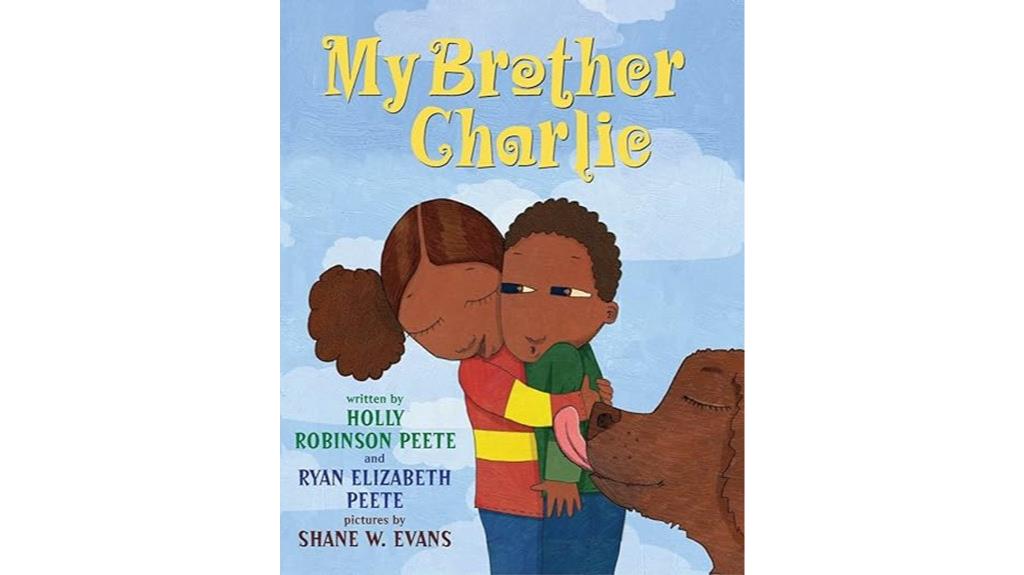Imagine a world where understanding differences is as easy as pie. That’s what these 15 best autism books for kids aim to do—create a bridge of empathy. With colorful illustrations and relatable characters, they tackle big themes like self-acceptance and emotional regulation. Curious about how these stories can spark conversations and foster connections? Let’s investigate how each book offers a unique perspective on autism and builds a more inclusive environment for everyone.
When Diggers Get Mad: A Children’s Picture Book Featuring Construction Vehicles

If you’re looking for a fun and effective way to help kids understand their feelings, “When Diggers Get Mad” is a fantastic choice! This book by Danielle Boudreau features charming construction vehicles that kids adore. It teaches them how to manage their anger in a relatable way. The rhymes and vibrant illustrations grab attention, keeping little ones engaged. Plus, it offers practical tips for calming down, making it perfect for parents and educators. Kids can relate to the story, especially those with emotional regulation challenges. It’s a delightful resource that combines learning with excitement, making feelings easier to understand!
Best For: Children, especially those who love construction vehicles and need support in managing their emotions.
Pros:
- Engaging rhyming text and vibrant illustrations captivate young readers’ attention.
- Provides practical tips for calming down, aiding emotional regulation.
- Highly relatable for children with emotional challenges, including those with Autism.
Cons:
- Some readers feel the book may be slightly long, which could affect engagement.
- The focus on anger may not cover a wider range of emotions.
- Limited appeal for children who are not interested in construction vehicles.
Autism and Me: An Empowering Guide for Kids Ages 8-12

“Autism and Me: An Empowering Guide for Kids Between 8-12 Years Old” is an incredible resource for kids steering through the unique challenges of Autism Spectrum Disorder (ASD). This guide features 35 interactive exercises, quizzes, and activities that make learning about your strengths and social skills fun. You’ll investigate your feelings and connect better with peers. Parents and educators love how it sparks meaningful conversations, too! This book isn’t just about understanding autism; it’s about embracing who you are. So, immerse yourself, and uncover how awesome neurodiversity can be. You’re not alone—this guide has your back!
Best For: Children aged 8-12 diagnosed with Autism Spectrum Disorder (ASD), as well as their parents and educators looking to foster understanding and self-acceptance.
Pros:
- Encourages self-reflection and emotional awareness through interactive activities.
- Facilitates meaningful conversations between children and adults about autism.
- Promotes acceptance of neurodiversity and helps children embrace their unique strengths.
Cons:
- Primarily targeted at younger children, which may limit applicability for teens or older kids.
- Some may find the interactive format less engaging if they prefer traditional reading.
- Limited content on more complex issues related to autism that older children might face.
My Brother Charlie

Looking for a heartfelt story that connects kids and families? “My Brother Charlie” is a fantastic choice! This book explores the bond between a twin sister and her autistic brother. It highlights the joys and challenges they face together. You’ll find themes of love, understanding, and communication that resonate deeply. Many readers, including parents and educators, appreciate how it promotes empathy and awareness. The beautiful illustrations add warmth to the story, making it perfect for young audiences. It’s a great tool for classrooms too, helping everyone learn about diversity and inclusion. Immerse yourself and uncover this touching tale!
Best For: Families, educators, and anyone looking to foster understanding and empathy towards autism through a heartfelt story.
Pros:
- Promotes empathy and awareness about autism among children and adults.
- Beautiful illustrations enhance the storytelling experience, making it engaging for young audiences.
- Serves as an effective educational tool for discussions on diversity and inclusion in classrooms.
Cons:
- May evoke strong emotions, which could be overwhelming for some readers.
- Limited to the experiences of one family, which might not represent all autistic individuals.
- Some readers may find the narrative too simplistic for older audiences or those seeking in-depth information about autism.
I Can Do Hard Things: Mindful Affirmations for Kids

For kids maneuvering the ups and downs of everyday life, “I Can Do Hard Things: Mindful Affirmations for Kids” is a fantastic choice. This book promotes resilience and emotional well-being, helping you tackle challenges like trying new things and managing tough emotions. With vibrant illustrations and relatable characters, it’s engaging and inclusive. Parents love how it sparks conversations about feelings and conflict resolution. You’ll find it perfect for bedtime or morning routines, reinforcing positivity and self-belief. Many families recommend it for nurturing emotional resilience. Immerse yourself in this empowering read; it might just inspire you to welcome those hard things!
Best For: “I Can Do Hard Things” is best for children navigating emotional challenges and parents seeking to foster resilience and self-belief.
Pros:
- Engaging and vibrant illustrations that captivate children’s attention.
- Encourages meaningful conversations about emotions and conflict resolution.
- Suitable for various settings, including bedtime routines and classrooms.
Cons:
- Some concerns about paper quality reported by a few readers.
- May require parental guidance to fully resonate with younger children.
- Limited focus on academic tasks, which might not appeal to all educational preferences.
My Magical Words – Teach Kids to Use Words for Confidence and Self-Esteem

If you want to help kids build their confidence and self-esteem, “My Magical Words” is a fantastic choice! This colorful book by Becky Cummings uses fun rhymes and stunning illustrations to teach kids about self-love. It’s like a magical toolbox filled with positive affirmations. When kids read it, they learn to appreciate their uniqueness and treat others kindly. Caregivers and teachers rave about its impact, noting improvements in kids’ attitudes and kindness. Plus, the engaging graphics keep them hooked! So, if you’re looking for a way to uplift young hearts, grab a copy of this enchanting book!
Best For: Parents, caregivers, and educators looking to enhance children’s self-esteem and promote kindness through engaging storytelling.
Pros:
- Engaging Illustrations: The colorful and captivating illustrations keep children interested and entertained.
- Positive Impact: Many caregivers report noticeable improvements in children’s confidence and kindness after reading the book.
- Fun Learning Tool: The rhyming affirmations make it a playful yet educational experience for kids to learn about self-love.
Cons:
- Durability Issues: Some reviewers noted minor concerns with the book’s durability, such as pages falling out.
- Limited Age Range: The content may be more suited for younger children, potentially limiting its audience.
- Repetitive Themes: A few readers mentioned that the affirmations could feel repetitive after multiple readings.
Masterpiece: An Inclusive Kids Book Celebrating a Child on the Autism Spectrum

“Masterpiece: An Inclusive Kids Book Celebrating a Child on the Autism Spectrum” is a fantastic choice for parents, educators, and anyone looking to foster understanding and empathy in kids. This vibrant book features Samuel, a boy on the autism spectrum who loves the color blue. Through bold illustrations and an engaging narrative, you’ll see the beauty in individuality and self-expression. Samuel’s classmates learn to appreciate his unique perspective, promoting kindness and acceptance. Plus, the positive portrayal of autism resonates with neurodivergent kids. You’ll find this book a valuable tool for sparking conversations about diversity and creativity. Give it a read!
Best For: Parents, educators, and anyone seeking to promote empathy and understanding of neurodiversity among children.
Pros:
- Bold, colorful illustrations that engage young readers and effectively represent autism awareness.
- Encourages acceptance and understanding of differences among peers, fostering kindness and empathy.
- Positive portrayal of autism, showcasing the joy and creativity of a neurodivergent child.
Cons:
- May not resonate with all children, particularly those unfamiliar with autism.
- Limited to a single narrative; some readers may desire more diverse experiences of neurodivergent individuals.
- The specific focus on autism might overshadow other important topics of diversity and inclusion.
Nathans Autism Spectrum Superpowers (One Three Nine Inspired Book 1)

“Nathan’s Autism Spectrum Superpowers” is an incredible choice for kids between 6 to 8 who are maneuvering through the world with autism. This book offers a fantastic glimpse into the mind of Nathan, an autistic child managing life. You’ll find positive insights on autism, celebrating unique strengths rather than focusing on limitations. It even includes cool tools, like the Over-reaction chart, to help manage overwhelming feelings. The colorful illustrations make it fun to read, too! Parents love how it builds understanding among siblings and friends. Immerse yourself and uncover the superpowers that make autism truly special!
Best For: Children aged 6-8 diagnosed with autism and their families seeking a positive understanding of autism.
Pros:
- Strengths-based perspective: Celebrates the unique strengths of autistic children, promoting a positive self-view.
- Practical tools: Includes helpful tools like the Over-reaction chart to assist in managing overwhelming emotions.
- Engaging illustrations: Features colorful and captivating illustrations that make the reading experience enjoyable for young readers.
Cons:
- Lengthy for younger kids: The book may be too long for some children in the lower age range, potentially affecting engagement.
- Small font size on mobile devices: Some readers have noted that the font can be small, which may hinder accessibility on certain devices.
- Limited scope for older children: The content is primarily tailored for ages 6-8, which may not fully resonate with older children on the spectrum.
Too Much!: An Overwhelming Day

“Too Much!: An Overwhelming Day” is an excellent choice for kids who struggle with sensory overload, especially those on the autism spectrum. This book grabs attention with its fun rhymes and engaging story. You’ll find it helps kids express their feelings, turning frustration into words instead of meltdowns. The beautiful illustrations make it a joy to read, and it’s a fantastic resource for parents and teachers alike. It sparks conversations about sensory differences, helping everyone understand and empathize better. Plus, it’s become a classroom favorite! So, if you’re looking for a way to navigate overwhelming days, this book is a must-have!
Best For: Children, particularly those with sensory issues or on the autism spectrum, who struggle with overwhelming feelings and sensory overload.
Pros:
- Engaging storytelling with rhymes that captivate children’s attention and encourage emotional expression.
- Beautiful illustrations that enhance the reading experience and make complex topics more relatable for young readers.
- Educational resource for parents and educators, fostering conversations about sensory processing and promoting empathy among children.
Cons:
- May not resonate with all children, particularly those without sensory processing issues.
- Some parents may find the length of the story challenging for very young or easily distracted children.
- Limited appeal for older children or those beyond the target age group, as the themes may seem too simplistic.
I See Things Differently: A First Look at Autism (A First Look at…Series)

If you’re looking for a fantastic way to introduce autism to young readers, “I See Things Differently: A Preliminary Look at Autism” is a perfect choice! This book offers a clear, friendly explanation of autism that resonates with kids and families. Parents rave about its ability to spark conversations, helping siblings understand their autistic family members better. The engaging illustrations and simple language make it accessible for everyone. Many schools recommend it to promote kindness and awareness. It’s not just informative; it’s a fun tool for building empathy. You’ll find it valuable now and as your children grow!
Best For: Families with autistic children, educators, and young readers seeking to understand autism in a friendly and accessible way.
Pros:
- Promotes understanding: Aids in discussions about autism, fostering empathy and awareness among siblings and peers.
- Engaging format: Features large text and vibrant illustrations that make it appealing and accessible for young readers.
- Educational tool: Recommended for use in schools to enhance inclusivity and kindness towards autistic individuals.
Cons:
- Limited depth: May not cover more complex aspects of autism, which could be a drawback for older readers or those seeking in-depth knowledge.
- Target audience: Primarily geared towards younger children, which might not fully engage older readers or adults looking for comprehensive information.
- Availability: Depending on the location, access to the book may be limited, affecting its widespread use in educational settings.
Just Ask!: Be Different, Be Brave, Be You

“Just Ask!: Be Different, Be Brave, Be You” is an excellent choice for kids and families looking to understand and celebrate differences among peers. Written by Supreme Court Justice Sonia Sotomayor, this book makes understanding disabilities easy and fun. It covers a variety of conditions, like ADHD, autism, and anxiety, with simple explanations. Gorgeous illustrations bring the text to life, sparking curiosity and discussion. Kids love sharing their own experiences, which deepens empathy and connection. Whether you’re in a classroom or at home, this book’s message of acceptance is powerful. It’s a must-have for promoting inclusivity and understanding among children!
Best For: Families and educators seeking to foster understanding and acceptance of disabilities among children.
Pros:
- Engaging Illustrations: The stunning and colorful visuals enhance the narrative, capturing children’s attention.
- Promotes Conversations: The book effectively sparks discussions among kids about differences and personal experiences.
- Diverse Coverage: It addresses a range of disabilities, making it a comprehensive resource for understanding various challenges.
Cons:
- Wordy Text: Some readers find the text a bit lengthy, which may require summarization for younger audiences.
- Limited Detail: The brief explanations of disabilities might leave some readers wanting more in-depth information.
- Age Suitability: While the book is designed for children, some concepts may be better suited for older kids or require adult guidance for younger ones.
Freebear Montessori Busy Book for Kids – Human Body Anatomy Activities

The Freebear Montessori Busy Book for Kids is an excellent choice for kids with autism and those who thrive on interactive learning. This engaging human body anatomy book features 15 pages filled with fun activities. You’ll investigate numbers, colors, letters, and body structures while having a blast! The compact size makes it perfect for travel or sharing with friends. Plus, you’ll enjoy hands-on play with a skeleton toy. While some assembly is needed, it’s a great opportunity for teamwork. This book not only entertains but helps develop understanding and communication skills. Prepare to plunge into anatomy fun!
Best For: Children aged 4-8, especially those with autism or those who benefit from interactive learning experiences.
Pros:
- Engaging educational activities that promote understanding of human anatomy.
- Compact and travel-friendly design, making it easy to carry and share.
- Hands-on play with a skeleton toy enhances interaction and teamwork.
Cons:
- Some assembly required, which may be challenging for parents and children.
- Occasional reports of missing pieces or anatomical inaccuracies.
- Clearer assembly instructions and better organization of components could improve the experience.
Different Thinkers: Autism

“Different Thinkers: Autism” is perfect for kids in the range of 6-12 who want to understand autism in a fun and relatable way. This engaging book uses simple language and interactive activities to explain autism. Authors Dr. Fredriksen and Dr. Rothman make complex topics easy to grasp and enjoyable. You’ll uncover how diverse brains work and what it means to be neurodivergent. Plus, this book normalizes conversations about autism, making it a hit with parents, kids, and teachers. Immerse yourselves in it with your family, and you’ll all learn something valuable while celebrating differences together!
Best For: Children aged 6-12, parents, and educators seeking to understand and discuss autism in an engaging and educational manner.
Pros:
- Engaging Storytelling: The book uses fun narratives and interactive activities to explain autism, making learning enjoyable for children.
- Accessible Language: Complex concepts are simplified, making it easy for young readers to grasp the idea of neurodiversity.
- Normalizes Conversations: It helps to normalize discussions about autism, fostering understanding and acceptance among peers.
Cons:
- Target Age Limit: The content is primarily geared towards children aged 6-12, which may not appeal to older audiences.
- Limited Depth: While it simplifies complex topics, some may find that it lacks in-depth exploration of autism for older readers or adults.
- Potential Over-Simplification: Some readers might feel that certain challenges faced by neurodivergent individuals are not fully addressed due to the book’s child-friendly approach.
Where Do You Poop? A potty training board book

Looking for a fun way to tackle potty training with your little one? “Where Do You Poop?” might just be the perfect fit! This colorful board book features interactive pull tabs that keep kids engaged while learning about bathroom habits. Its vibrant illustrations grab attention, making it a hit for toddlers. Parents have found it super effective, with many kids excited to read it multiple times. The simple language and fun characters turn potty training into an adventure. Plus, it encourages family involvement, creating a supportive atmosphere. In general, it’s a fantastic tool to make potty training enjoyable and less intimidating!
Best For: “Where Do You Poop?” is best for toddlers aged 2 to 3 years who are starting their potty training journey.
Pros:
- Engaging interactive pull tabs keep children interested and involved in the learning process.
- Vibrant illustrations and fun characters make potty training feel like an exciting adventure.
- Encourages family participation, fostering a supportive environment during potty training.
Cons:
- The book may not hold the attention of older children who are beyond the potty training stage.
- Some children may not respond to the humor or themes, making it less effective for them individually.
- Sturdy pages can be a bit heavy for very young toddlers to handle comfortably.
Social-Emotional Learning Activities for Autistic Kids (Ages 5-10)

If you’re searching for a fantastic resource to help autistic kids in the range of 5-10 flourish in social settings, “Social-Emotional Learning for Autistic Kids” is a top choice. This book’s packed with fun activities that help kids express their feelings and build social skills. You’ll find engaging exercises like belly breathing and counting to calm down, perfect for different needs. Plus, it promotes a positive view of neurodiversity, which is super significant. Parents and educators love how practical it is for everyday use, making it a must-have for any home or school library. Your kids will thank you!
Best For: Parents and educators of autistic children aged 5-10 looking to enhance social-emotional skills.
Pros:
- Encourages self-expression and emotional understanding through engaging activities.
- Promotes a positive view of neurodiversity, fostering acceptance and self-advocacy.
- Practical and adaptable for use in various everyday situations at home and school.
Cons:
- Some skepticism exists regarding the effectiveness of strategies from non-autistic professionals.
- May require additional resources or support for some families to fully implement activities.
- Individual needs of children may vary, making not all activities suitable for every child.
Uniquely Wired: A Story About Autism and Its Gifts for Kids ages 6-9

“Uniquely Wired: A Story About Autism and Its Gifts for Kids in the 6-9 year bracket” is a fantastic choice for parents and educators looking to introduce young readers to the world of autism. This book shines by celebrating the small victories of autistic kids, like buckling up and sharing hugs. It explains autism in a way that’s easy to grasp, making it relatable for both autistic children and their peers. Parents love how it sparks conversations, especially for those newly diagnosed. Plus, educators find it useful for fostering empathy in classrooms. Grab a copy—it’s a delightful way to promote understanding!
Best For: Parents and educators seeking to introduce children aged 6-9 to the concept of autism and promote understanding among peers.
Pros:
- Celebrates small victories that autistic children achieve, fostering a positive perspective.
- Accessible explanations of autism make it relatable for both autistic children and their peers.
- Encourages conversations about autism, useful for families and educators in promoting empathy.
Cons:
- May not cover all aspects of autism, potentially leaving out some experiences.
- Targeted age range (6-9) might limit its appeal to older children or adults seeking in-depth knowledge.
- Illustrations, while engaging, may not resonate with every child’s preferences or learning styles.
Factors to Consider When Choosing Autism Books for Kids

When you’re picking out autism books for kids, there are a few key things to keep in mind. Think about developmental stage—books should resonate with their stage of development. Also, look for engaging illustrations, relatable characters, and positive messages that spark joy and connection!
Age Appropriateness
Choosing the right autism books for kids is super essential, and developmental stage appropriateness plays a big role in this. When you pick a book, check the recommended age range. For younger kids (3-5), look for simple language and colorful illustrations that keep them interested. As kids grow (ages 6-9), stories can get more complex, introducing relatable characters and deeper discussions about autism. Ultimately, for older children (8-12), choose books with interactive activities that encourage self-reflection and improve social skills. It’s all about making sure the content resonates with their experiences. The more relatable the book, the more they’ll connect with it. You want them to feel understood and engaged, right? Happy reading!
Engaging Illustrations
Engaging illustrations can make a huge difference in how kids connect with autism books. The right artwork grabs attention and helps kids grasp complex ideas through visual storytelling. Colorful and relatable images convey emotions, making the stories enjoyable and easier to understand. Look for books that showcase diverse characters in different situations—this representation promotes empathy and acceptance. When kids see themselves and their peers in the illustrations, it sparks significant conversations about autism and social-emotional learning. Plus, high-quality visuals can ignite creativity and imagination, pulling them deeper into the narrative. So, when you’re choosing an autism book, don’t overlook those enthralling illustrations—they’re more than just decoration; they’re a key to understanding!
Positive Messaging
Books filled with positive messaging can really light up a child’s understanding of autism. When you choose books that celebrate neurodiversity, you’re helping kids accept who they are. These stories highlight individual strengths and unique traits, making self-acceptance feel powerful. Plus, using identity-first language can elevate self-esteem and pride in being autistic.
Look for relatable characters who tackle social situations successfully. They provide role models and strategies for kids to navigate their own challenges. Engaging illustrations and inclusive storytelling improve these positive themes, making the messages stick. By focusing on uplifting narratives, you create an environment where empathy flourishes and stigma fades away. So, pick those books that shine a light on the amazing skills and qualities our autistic friends bring to the world!
Interactive Elements
There’s something special about interactive elements in autism books for kids. They’re like the secret sauce that makes learning fun! Quizzes, activities, and pull tabs grab attention and keep kids engaged. Plus, hands-on tasks help them express feelings and tackle social situations, enhancing emotional awareness.
Books featuring real-life scenarios let kids practice essential skills in relatable ways. This promotes a deeper understanding of concepts they encounter. Engaging illustrations and vibrant visuals also play a key role, making complex ideas easier to grasp.
Interactive features encourage repeated readings, too! This repetition reinforces learning and opens up valuable conversations about autism and emotions. So, when you’re picking a book, look for these interactive elements. They can make all the difference!
Relatable Characters
Finding books with relatable characters can really improve your reading experience. When you read about characters who share similar challenges and triumphs, it makes the story feel personal. You see yourself reflected in their path, and that’s powerful. Characters with autism facing everyday situations help build empathy and understanding. Plus, when they showcase unique strengths, it encourages you to accept your own individuality. These characters can be role models, showing you how to handle social situations with confidence. By including accurate portrayals of autism, these books normalize conversations about differences and acceptance. So, grab a book with relatable characters—you’ll not only enjoy the read, but you’ll also cultivate a deeper understanding of the world around you.
Educational Value
When you’re on the hunt for autism books for kids, it’s vital to reflect on their educational value. Look for books that include interactive activities. These can promote engagement and strengthen social skills. Clear, developmental explanations of autism are important too. They should simplify complex ideas without overwhelming young minds.
Prioritize titles that highlight strengths associated with autism. This can enhance self-acceptance and resilience. Relatable examples and scenarios help kids connect with their own experiences and those of others.
Lastly, choose resources that spark discussions about neurodiversity and acceptance. This encourages empathy in both autistic children and their peers. With the right book, you’re not just reading; you’re building understanding and compassion for everyone involved.
Conclusion
To sum up, these 15 autism books are more than just stories; they’re gateways to understanding and empathy. They spark conversations, inspire acceptance, and highlight the beauty of differences. By reading these books, you’ll learn about emotions, build connections, and welcome diversity. So, grab a book, share it with a friend, and let the adventure of exploration begin. Together, we can create a kinder world where everyone feels valued and understood. Happy reading!










